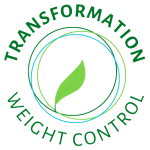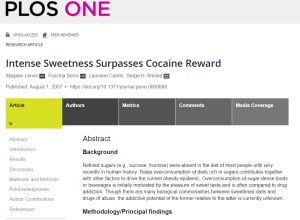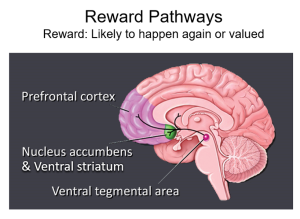
Rich Weil, M.Ed., CDE
Founder and Director
Transformation Weight Control
www.transformationweightcontrol.com
Sugar addiction is very common and powerful. Sugar can be more addictive than cocaine in rats, and humans as well. In fact, if you looked at an image from an MRI of the brain lighting up when a rat or human is presented with sugar or cocaine, the image would look virtually the same; the same region of the brain is activated whether it’s sugar or cocaine. It is well known and proven in research that the behavioral and neurobiochemical (brain biochemistry) characteristics of substance abuse (e.g., cocaine, alcohol, opiates) and overeating are quite similar.

Source: https://journals.plos.org/plosone/article?id=10.1371/journal.pone.0000698
Definitions:
Reward Pathway: The reward pathway is a set of brain structures that control and regulate pleasure. It connects the ventral tegmental area (VTA) in the midbrain to the ventral striatum in the forebrain (see picture below). Foods that you like a lot, or that trigger cravings, are known to have a high reward value. Sugar has a high reward value and exhibits drug-like effects in the reward center of the brain.
Ventral tegmental area: The VTA is a midbrain structure that plays a key role in reward-related behaviors. It’s made up of a small group of neurons that produce dopamine, a neurotransmitter often called the “feel-good” chemical.
Ventral striatum: The VS is a large region of the brain that plays a central role in processing reward in the reward pathway. It is often called the brain’s reward center. It’s located in the center of the brain, just above and behind the ears.
Neurotransmitter: A chemical that allows neurons to communicate with each other throughout the body.
Neurons: Nerve cells that send messages all over your body to allow you to do everything from breathing to talking, eating, walking, and thinking.
Dopamine: A chemical messenger in the brain that helps nerve cells send messages to each other. It’s often called the “feel-good” or “happy” hormone because it’s a primary driver of the brain’s reward system and can give you feelings of pleasure, satisfaction, and motivation. Dopamine levels increase when you experience something pleasurable, such as achieving something, doing something fun, or smelling or eating food! Sometimes it’s known as a “dopamine rush,”. Dopamine is produced in the ventral tegmental area described above.
Receptor: Receptors are proteins located either inside a cell or on its surface. Their job is to receive chemical signals that activate and tell the cell to do what it’s programmed to do. For instance, a sweet receptor is sensitive to sugar and sweet foods, so when sugar stimulates the sweet receptor, the cell sends a signal to your brain that gives you the pleasure that you get from eating sweets. This also drives your need and desire for more sugar and sweets.
Detoxify: To free yourself from the dependence or addiction to an intoxicating substance that causes your body harm.

The Facts About Sugar in the Brain
In the brain, excess sugar impairs both our cognitive skills and our self-control, which increase our impulsivity. Increased impulsivity can lead to overeating and subsequent weight gain. For many people, having a little sugar stimulates a craving for more. Over time, greater amounts of sugar consumption diminish the sugar reward response such that more sugar is required to reach the same level of reward that you got from smaller amounts of sugar before things got worse. All of this means that you progressively need more sugar to get your “sugar rush”. Sugar addiction is exactly that; a diminished reward response which progressively gets worse and drives the need for more sugar to get the same pleasure. This works in the same way for addiction to foods rich in salt and fat.
Why Sugar and Sweetness Are So Potent
Besides the decrease in the sugar reward pathway caused by the overconsumption of sugar, which drives the need for more sugar and sweets, it just so happens that there are two sets of sweet receptors in our body. The first set is in the mouth, on the tongue taste buds, and the second set is lower down in your throat. This means that you get a double whammy of sweet sensation. First in the mouth, then in the throat after you swallow it. That there are two sets of sweet taste receptors was only recently discovered in the past 10 years or so, and partially explains why our senses are so heightened by sugar and sweetness, and explains the cravings we get for sweetness.
Between the decrease in the reward pathway from overconsumption of sugar and sweets, the addiction that is caused by it, and multiple sets of sweet receptors, the story of cravings and addictions for sugar and sweetness all falls into place.
What Can Be Done?
Many strategies exist for managing or breaking the sugar addiction. Below is an inclusive list. I caution you to be patient. It took years for you to build up your addiction, but the good news is that it can take just a few weeks to detoxify yourself. For instance, in our weight loss program, for individuals who show up drinking 5- to 6-liter bottles of sweetened beverages such as soda a day, it can take up to two weeks to detoxify. But once they get past it, they report that food tastes better (the palate improves), and foods such as vegetables taste sweeter. All that overconsumption of sweets and sugar was altering your taste perception, but the palate, and taste perception, improves and returns to normal once you stop the overconsumption, and food tastes different, and better. Our bodies are amazing machines, and if we treat them in a healthy way, the hard work pays off and becomes worth the effort.
Strategies for Overcoming Sweet and Sugar Cravings and Addiction
Stay Hydrated: Sometimes people eat when they are thirsty. If you feel an urge or craving, especially for sweets, and you’ve recently eaten, have a glass of water first, wait 10 to 15 minutes, and see if the craving for sweetness doesn’t pass away. It’s a good general rule to drink eight, 8-ounce glasses of water a day.
Gradually reduce your dependence. Starting gradually will minimize any symptoms of withdrawal. We recommend switching to lower calorie sweet foods. Our favorites are lifesavers, and the best of all, tootsie pops! They are both sweet, low in calories, take some time to finish if you suck on them and don’t chew them, and with a tootsie pop you get a special treat at the end once you’ve sucked the candy out of the way, a tootsie roll! Chewing gum also helps.
Select foods such as fruits, vegetables, lean proteins, and whole grains, which are naturally lower in sugars, often higher in fiber, and higher in nutrients. Nuts, yogurt (without added sugars), or whole-grain crackers can also be helpful substitutions.
Get 7 hours of sleep a night. Less sleep is associated with higher levels of hormones that make you hungry. Sleep is a difficult behavior to change. Keep your room at a comfortable temperature, avoid light, especially flashing light, from outside (use black-out shades), avoid using any device or monitor while in bed before you go to sleep. The light from these devices will keep you awake. Check the National Sleep Foundation for detailed descriptions of sleep hygiene https://www.thensf.org/
The obvious strategy. Mix your meals with protein, healthy fats, fiber, and about 40% of your calories from carbohydrate, to help stabilize blood sugar levels and reduce cravings.
Stress increases triggers and cravings for sugary foods. Exercise, meditation, and hobbies can be helpful. In our program, we like adult coloring books to keep you and your hands busy. There’s also research to show that playing with modeling clay will reduce cravings (something about getting your hands involved and distracting yourself) or even counting backwards from 100 has been shown to reduce cravings for sweets.
Reach out for help. Find a “food” or “sugar” buddy, someone you trust and can count on to call or text when you feel the cravings coming on. If you’re comfortable, share your goals with friends or family who can support you.
Mantras are a terrific help for changing behavior. Our favorite is, “I don’t do that anymore.” When the craving for sweets hits you, and you feel like surrendering to the desire, repeat out loud to yourself, “I don’t do that anymore.” We also like, “See ya later!” when the craving hits.
Dissociate from yourself. Speak to yourself in the third person. Distance yourself from the experience, your thoughts, and your feelings. Say, “John, do you really want that sweet, is it going to help you?” “Mary, how are you going to feel if you have it?” This is consequential thinking. If you really do want it, but you have control over the decision, chances are you will consume less of it. This is a good starting point.
Urge surf. Sit with your thoughts and feelings for a few moments, breathe normally, slow your heart rate down, and see if the craving doesn’t pass. Some people report it only takes a few minutes. Think about the surf at the beach. The waves often come in strong and large, you brace yourself (or ride it), and then once the wave breaks, there is calm and silent water behind it. That’s urge surfing.
Guided imagery, Body scanning, and Meditation have a role in controlling sweet cravings. There are tons of You Tube videos online that can help with all of these. Find one you like and practice. Giving the craving time to pass, like in urge surfing, can have great value in calming your anxiety and arousal, and gain control over your thoughts and desires. Sometimes it can work in just minutes.
Where did the food come from? Did you bring the food home? Did someone else? What’s it doing there? It’s hard sometimes when you live with others, especially children. We like the strategy of keeping a separate cupboard for each person who lives in the house. Even put a piece of tape on the cupboard door with the family member’s name on it. And make a rule that the only cupboard you open is your own. This will give you a sense of control. There is no question that sight is the strongest sense for cravings; more than smell, taste or touch. If you don’t see it, it’s less likely to call to you. The adage, “Out of sight, out of mind” applies here.
Do a Behavior Chain Analysis. Look over your day. Identify high stress, high-risk situations that might be behind the craving or desire for sweets. What was going on? What was your mood? Where were you? Who were you with? What was the context and environment that lead to the craving? Identify choice points, the moment when you might have been able to gain control. Create coping cards, (writing notes on index cards) that will remind you of what to do when inevitable cravings happen.
As I mentioned, be patient. And own and celebrate your victories! A few less sweets is a victory. All-or-nothing, perfectionistic thinkers never think any improvement is enough. Do your very best to congratulate yourself and pat yourself on the back for any victory. And when you catch yourself beating yourself up or thinking you’re a failure, ask yourself three questions: 1) is what you’re thinking true? 2) Is your thinking being kind to yourself, that is, would you talk to anyone else in need of help the way you’re talking to yourself? and 3) is it helping you to think the way you are?
© 2024 Richard Weil, All Rights Reserved